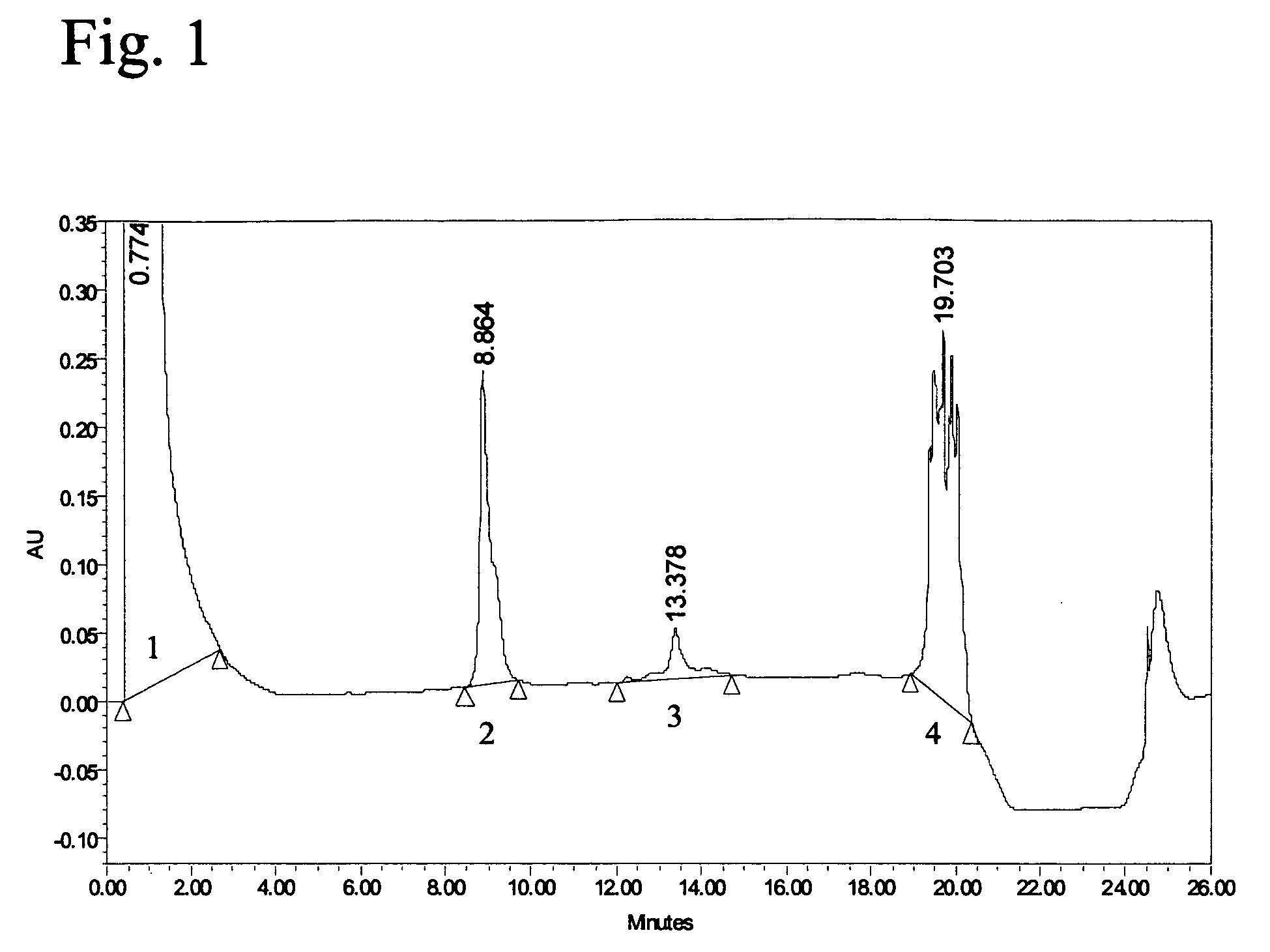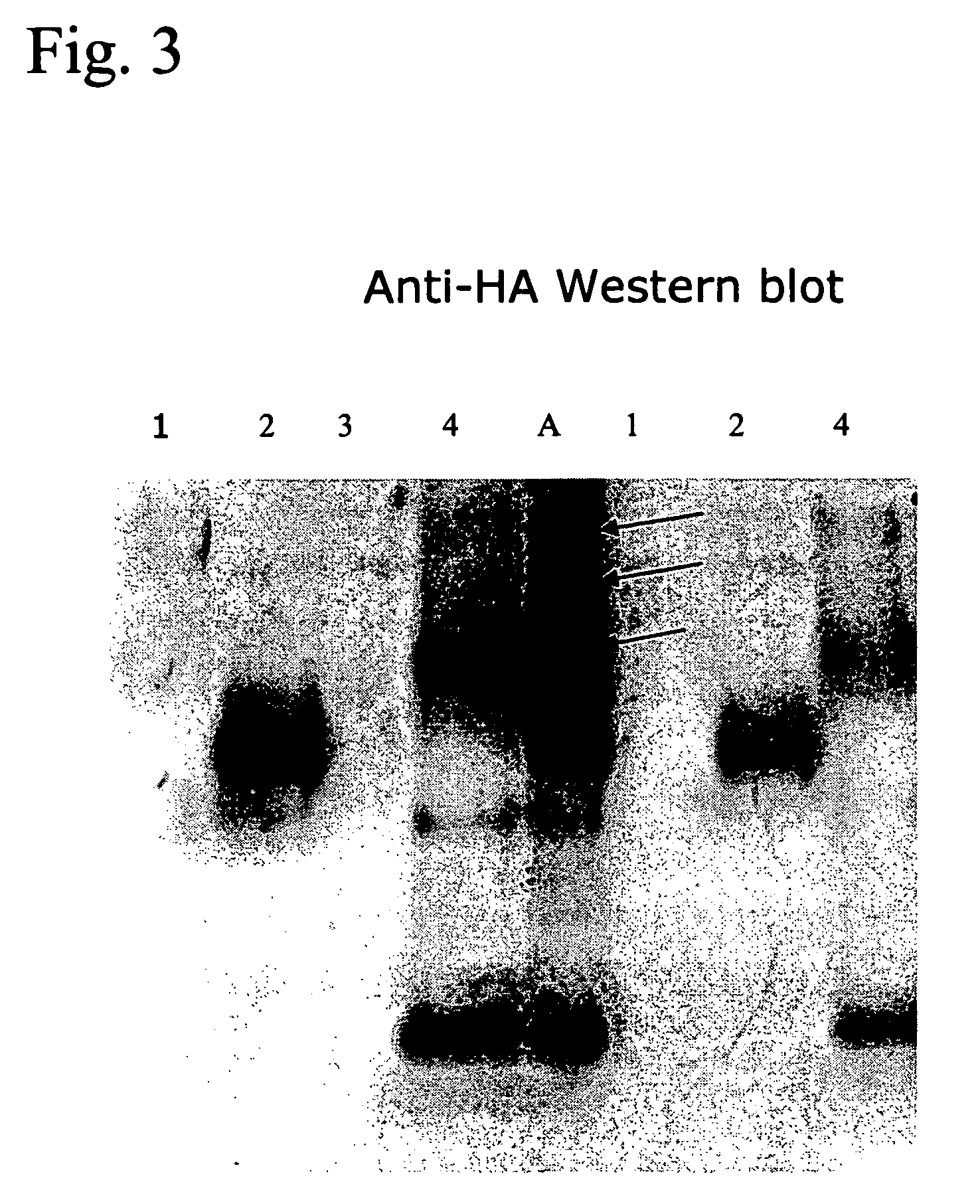Novel assay for the separation and quantification of hemagglutinin antigens
a technology of hemagglutinin and quantification, which is applied in the field of vaccine manufacturing, can solve the problems of not leaving room for very high throughput, time-consuming, laborious, and insufficient separation of various virus components, and achieves the effect of prolonging the incubation tim
- Summary
- Abstract
- Description
- Claims
- Application Information
AI Technical Summary
Benefits of technology
Problems solved by technology
Method used
Image
Examples
example 1
Determination of hemagglutinin in influenza preparations of A / Panama / 2007 / 99 (Resvir-17; H3N2) using Reversed Phase HPLC
[0070] The egg-derived influenza antigen preparation A / Panama / 2007 / 99 (Resvir-17; H3N2) from NIBSC and the same antigen produced on PER.C6®-based technology, were analyzed on Reversed Phase-HPLC (RP-HPLC).
[0071] The production of antigen produced on PER.C6® cells was performed as follows: PER.C6® cells (as represented by the human embryonic retina (HER) cells under ECACC no. 96022940 deposited with the European Collection of Cell Cultures (ECACC) at the Centre for Applied Microbiology and Research (CAMR), Salisbury, Wiltshire, UK, see, e.g., U.S. Pat. No. 5,994,128 to Fallaux et al.) were cultured in a bioreactor (37° C., DO=50%, pH 7.3) until a viable cell density of 1×106 cells / ml was accomplished. The cells were infected with influenza viruses of the strain Resvir-17 (H3N2) (35° C., with a multiplicity of infection of 1×10−4) in the presence of 3 μg / ml trypsin...
example 2
Determination of hemagglutinin in influenza preparations of A / Duck / Sing (H5N3) and A / New Caledonia (H1N1) using Reversed Phase HPLC
[0080] Further, it was investigated whether the RP-HPLC assay was also applicable for hemagglutinins from other influenza A subtypes. Hence, the selectivity of the assay with two other influenza A subtypes, A / Duck / Sing (H5N3) and A / New Caledonia (H1N1) was determined.
[0081] First, an RP-HPLC was performed on egg-derived and formaldehyde-treated H5N3 from A / Duck / Sing. For this an amount corresponding to 3.0 μg HA was injected. Further procedures were as described in Example 1, except that instead of SDS, ZWITTERGENT® 1% (w / v) was used as the detergent. In FIG. 7, a Reversed Phase chromatogram of the reduced / alkylated H5N3 antigen is shown. SDS-PAGE and subsequent silver staining (FIG. 8) of the proteins demonstrated that fraction 2b contained most, if not all HA1 (Lane 2b). Notably, peak 1 (lane 1 in FIG. 8), although eluting first after the flow throug...
example 3
RP-HPLC assay linearity for quantification of HA of egg-derived influenza A subtype H3N2
[0084] One of the key criteria of an analytical procedure is linearity, the ability (within a certain range) to obtain test results, which are directly proportional to the concentration (amount) of analyte in the sample. Assay linearity was studied with egg-derived, formaldehyde-inactivated, reduced and alkylated influenza antigen from A / Panama / 2007 / 99 (A / Resvir-17; H3N2). Increasing concentrations of HA were injected on the RP-HPLC system with a constant injection volume of 200 μl, and subsequently plotted versus the measured area of the HA1 peak, resulting in a calibration curve as shown in FIG. 1I A. It is evident from the data in FIG. 11A, that the assay linearity in the range between 0.3 and 10.6 μg HA injected was very good, as indicated by a correlation coefficient (R2) of more than 0.99. In principle, the real working range is also determined by the accuracy of the HA concentration of th...
PUM
| Property | Measurement | Unit |
|---|---|---|
| temperatures | aaaaa | aaaaa |
| temperature | aaaaa | aaaaa |
| temperature | aaaaa | aaaaa |
Abstract
Description
Claims
Application Information
 Login to View More
Login to View More - R&D
- Intellectual Property
- Life Sciences
- Materials
- Tech Scout
- Unparalleled Data Quality
- Higher Quality Content
- 60% Fewer Hallucinations
Browse by: Latest US Patents, China's latest patents, Technical Efficacy Thesaurus, Application Domain, Technology Topic, Popular Technical Reports.
© 2025 PatSnap. All rights reserved.Legal|Privacy policy|Modern Slavery Act Transparency Statement|Sitemap|About US| Contact US: help@patsnap.com



